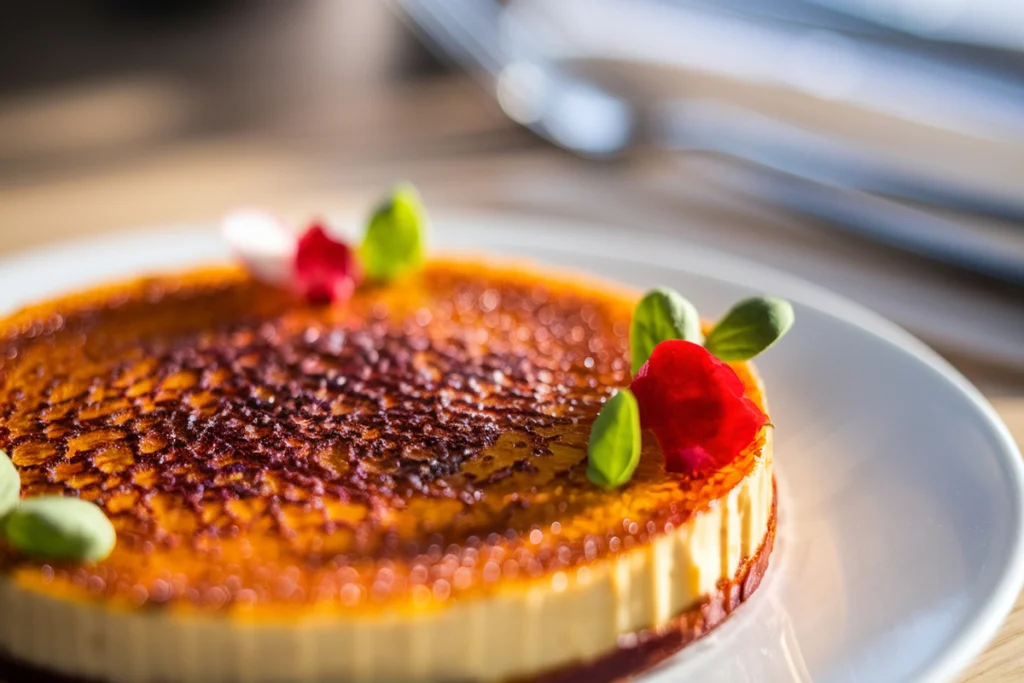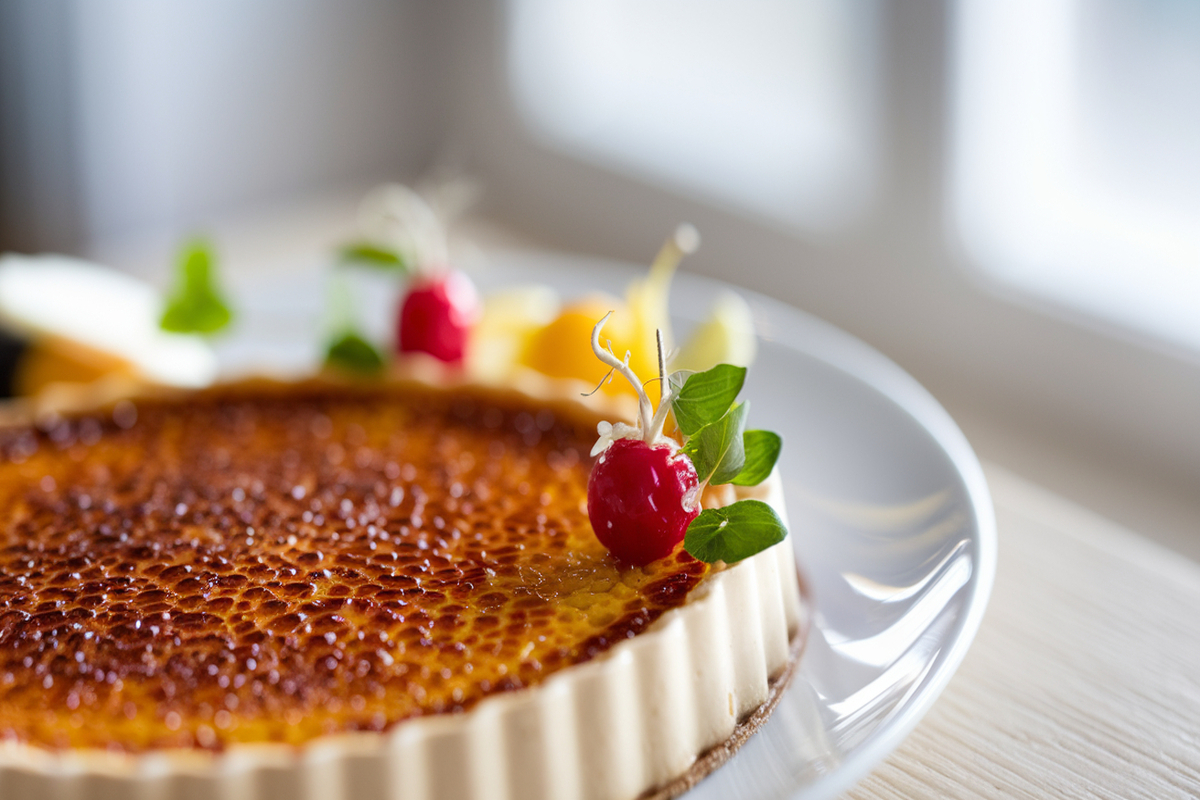Table of Contents
Introduction: Can you use store-bought custard for crème brûlée?
Imagine cracking into a glossy caramelized sugar crust to reveal a velvety, vanilla-specked custard beneath—all without spending hours in the kitchen. Crème brûlée, the French dessert that translates to “burnt cream,” is often seen as a restaurant-only treat. But what if I told you that store-bought custard could be your secret weapon for whipping up this elegant dessert in minutes?
I’ll never forget the time I attempted from-scratch crème brûlée for a dinner party… only to end up with lumpy custard and a kitchen smelling like burnt sugar. Enter store-bought custard: my ultimate shortcut. Not only does it save time, but it also guarantees a silky base every time. Think of it like my “Cheater’s Chocolate Mousse” recipe (a fan favorite!), where a few smart swaps turn a fussy dessert into a weeknight win.
Whether you’re a busy parent or a dessert newbie, these hacks let you serve a showstopper that’s creamy, dreamy, and totally foolproof. Let’s dive in!
What is Crème Brûlée?
Crème brûlée: a name that sounds like it requires a French accent and a culinary degree, right? Spoiler: it’s just custard with a sugar hat. But why the fancy title? Legend says it was accidentally “invented” when a chef left cream and sugar too close to a hot oven. The result? A cult classic.
They say “the way to someone’s heart is through their stomach,” but I’d argue it’s through the crack of a perfectly torched crème brûlée. Want to play hero at your next gathering? Let’s make magic with a carton of store-bought custard and a sprinkle of courage.
Why You’ll Love This Recipe

- Effortless Elegance: Skip the tempering eggs and stirring for hours. Store-bought custard is your shortcut to a luxe dessert.
- Budget-Friendly: Why pay $10 a pop at restaurants when you can make six servings for half the price?
- Customizable Wow Factor: Top it with turbinado sugar for that signature snap or add citrus zest for a zingy twist.
Love homemade custard? Try my Classic Crème Brûlée recipe next! But for nights when time’s tight, this hackable version is your golden ticket. Ready to torch like a pro? Let’s go!
How to Make Crème Brûlée with Store-Bought Custard
Quick Overview
Transform store-bought custard into crème brûlée in 20 minutes (plus chilling). The three hacks? Thicken the base, boost flavor, and nail the caramelized crust.
Key Ingredients
- 2 cups store-bought custard
- 4 egg yolks (optional, for thickening)
- 1 tsp vanilla extract (if custard is plain)
- ½ cup superfine sugar
Step-by-Step Instructions
Hack 1: Thicken the Base
Store-bought custard can be thin. Fix it by whisking in 4 egg yolks and simmering gently until it coats the back of a spoon.
Hack 2: Boost Flavor
Stir in vanilla, citrus zest, or a splash of bourbon. Pour into ramekins and chill for 2+ hours.
Hack 3: Caramelize Like a Pro
Sprinkle 1 tbsp superfine sugar over each ramekin. Torch in circular motions until golden and bubbly. No torch? Use the broiler for 1-2 minutes!
What to Serve With Crème Brûlée
- Espresso or Earl Grey tea for a bitter contrast.
- Fresh berries to cut the richness.
- A drizzle of salted caramel for overachievers.
Top Tips for Perfecting
- Chill First: Cold custard = better caramelization.
- Sugar Matters: Superfine sugar melts evenly.
- Torch Smart: Keep the flame 2 inches away to avoid burning.
Storing and Reheating Tips

Store custard (without sugar) in ramekins for up to 3 days. Add sugar and torch just before serving. Already torched? Eat within 24 hours—the sugar softens over time.
FAQs: Can you use store-bought custard for crème brûlée?
1. Can I use any store-bought custard for crème brûlée?
Yes, but opt for a high-quality, thick custard (avoid “pouring” varieties). If your custard is too runny, use Hack #1 (adding egg yolks) to thicken it.
2. What if I don’t have a kitchen torch?
No problem! Use your oven’s broiler. Place sugared ramekins on a baking sheet, broil for 1–2 minutes, and watch closely to avoid burning.
3. Why does my sugar topping melt unevenly?
Superfine sugar works best—it caramelizes smoothly. Avoid coarse sugar, and spread it in a thin, even layer before torching.
4. Can I make this vegan?
Yes! Use a dairy-free custard (like coconut or almond milk-based) and swap regular sugar for coconut sugar. Torch as usual.
5. How long can I store the custard base before torching?
Up to 3 days in the fridge. Add sugar and torch just before serving for maximum crunch.
Conclusion: Can you use store-bought custard for crème brûlée?
Let’s be real: Crème brûlée is supposed to feel fancy, but it doesn’t have to be fussy. With these three hacks, that store-bought custard sitting in your fridge becomes the ultimate dessert cheat code. Whether you’re salvaging a last-minute dinner party or treating yourself to a midweek indulgence, this recipe proves that elegance doesn’t require exhaustion.
Remember my kitchen disaster story? Now, I keep a carton of custard in my pantry at all times—just in case crème brûlée cravings strike (or my in-laws show up unannounced). The best part? No one will guess your secret. They’ll be too busy raving about the crackly caramel crust and that silky custard beneath.
So, grab that torch (or broiler pan!), and let’s turn “Can I really do this?” into “I nailed this!” Your future self—and your dessert-loving friends—will thank you.
Print
Easy Crème Brûlée Recipe
- Total Time: 2 hrs 25 mins
- Yield: 4 servings 1x
- Diet: Vegetarian
Description
Transform store-bought custard into a luxuriously creamy crème brûlée with just 3 simple hacks! Perfect for impressing guests or treating yourself, this recipe skips the fuss but keeps the elegance of crackly caramelized sugar and silky custard.
Ingredients
- 2 cups high-quality store-bought custard (thick, not pourable)
- 4 large egg yolks (optional, for thickening)
- 1 tsp pure vanilla extract (if custard is unflavored)
- ½ cup superfine sugar (for caramelizing)
- Optional add-ins: 1 tsp citrus zest, 1 tbsp bourbon, or ½ tsp cinnamon
Instructions
- Thicken the Custard (Optional):
Whisk egg yolks into store-bought custard. Simmer over low heat, stirring constantly, until thickened (5-7 mins). Cool slightly. - Flavor Boost:
Stir in vanilla, citrus zest, or bourbon. Divide into 4 ramekins. Chill 2+ hours. - Caramelize the Sugar:
Sprinkle 1-2 tbsp superfine sugar evenly over each ramekin. Torch in circular motions until golden and bubbly (or broil 1-2 mins). Serve immediately!
Notes
- No Torch? Use your oven’s broiler—watch closely to avoid burning.
- Vegan Option: Swap custard for coconut milk-based version and use coconut sugar.
- Storage: Keep un-torched custard in ramekins for up to 3 days.
- Prep Time: 20 mins
- Cook Time: 5 mins (plus 2 hrs chilling)
- Category: Dessert
- Method: No-Bake (Broiler Optional)
- Cuisine: French
Nutrition
- Serving Size: 1 ramekin
- Calories: ~300
- Sugar: 28g
- Sodium: 80mg
- Fat: 15g
- Saturated Fat: 8g
- Unsaturated Fat: 5g
- Trans Fat: 0g
- Carbohydrates: 35g
- Fiber: 0g
- Protein: 5g
- Cholesterol: 210mg (without egg yolks: 50mg)
Keywords: Easy crème brûlée, 3-ingredient dessert, quick caramelized custard

